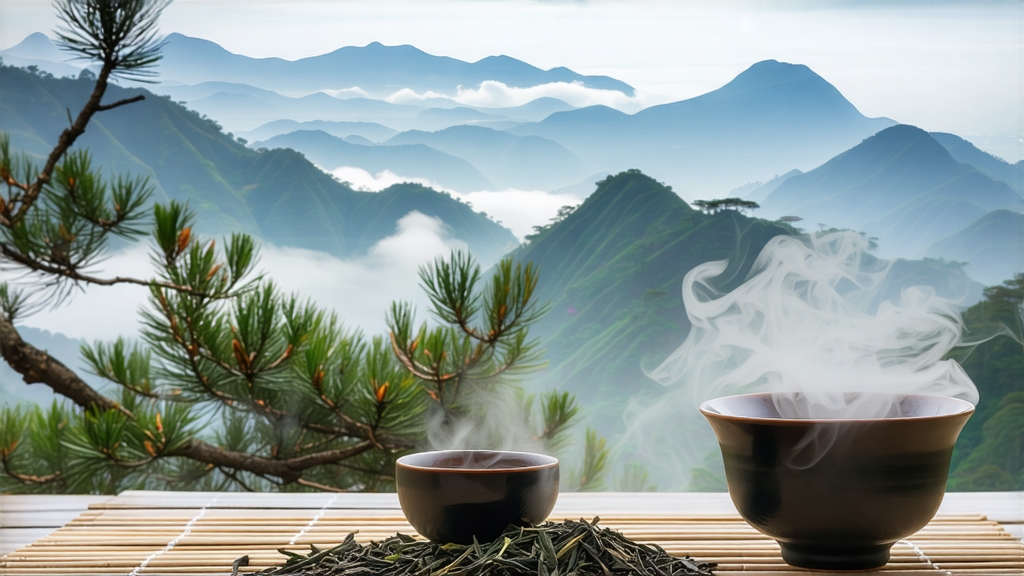
Long before English breakfast blends and afternoon tea services, there was Lapsang Souchong—the very first black tea ever created and the leaf that would rewrite global palates. Its birthplace is the Wuyi Mountains of northern Fujian, a UNESCO biosphere reserve where sheer cliffs, mineral-rich soils and a perpetual cloak of mist nurture the xiao zhong cultivar. Locals translate “xiao zhong” as “small cultivar,” yet the name that travelled the world was the Cantonese “Lapsang,” meaning “pine village,” a nod to the smoke that once drifted from every tea hut in Tongmu Guan.
The origin story is set in the late Ming dynasty, around 1646. Qing soldiers were marching through the mountains; villagers, panicked that fresh leaves would wither before they could finish the usual green-tea routine, rushed the harvest over open pine fires. The resulting liquor was copper-red, honey-sweet and carried an arresting scent of campfire and dried longan. Dutch traders tasting it at the port of Xiamen christened it “bohea” (from the local “Wu-i”) and shipped it to London coffeehouses, where it became the prototype for every black tea that followed. By the early 1700s Lapsang Souchong commanded more than twice the price of green tea at European auctions, effectively launching the West’s centuries-long obsession with fully oxidized leaves.
Today the tea is still protected by origin law: only leaf picked within the 565 km² core of the Wuyi reserve may bear the name “Zheng Shan Xiao Zhong” (Original Mountain Small Cultivar). Two distinct styles are produced. The traditional, smoke-dried version uses the same pine-wood technique codified four centuries ago; the “unsmoked” or “modern” style, developed for the domestic Chinese market, omits the final firing stage, yielding a maltier, cocoa-laced cup that showcases the leaf’s natural fruit notes. Both begin with the same two-leaves-and-a-bud pluck in late April, when overnight temperatures dip to 12 °C, slowing growth and concentrating amino acids.
Crafting either style is a six-step choreography that stretches across twenty-four hours. Withering happens on bamboo trays set high inside wooden lofts whose shutters are opened at dusk to invite cool mountain air; the leaf loses 60 % of its moisture while absorbing the resinous scent of the surrounding pine forest. Rolling follows, once done by foot in wide woks, now by machine that mimics the kneading motion of human wrists. Oxidation is brief—only 75 to 90 minutes—because the goal is a reddish-orange rather than a deep brown liquor. The critical divergence occurs at the drying stage. For smoked Lapsang, workers spread the oxidized leaf on sieves suspended over a pinewood pit that has been smouldering for days; the fire is never allowed to flame, only to exhale a cool, aromatic smoke that perfumes the leaf for eight hours. Unsmoked lots are instead baked at 85 °C in electric ovens, turning every twenty minutes until the moisture content drops to 3 %. Finally, the tea is hand-sorted into grades: Si Chun (superfine), Te Ji (special), and Jing Dian (classic), each defined by the proportion of tips and the uniformity of twist.
To brew Lapsang Souchong gongfu style, use 5 g of leaf in a 120 ml gaiwan. Rinse once with 95 °C water to awaken the leaf, then steep for 5, 10, 15, 25, 40 and 60 seconds. The first infusion releases a burst of pine resin that quickly yields to dried apricot and cinnamon; by the third, the smoke recedes into a background note of toasted cedar while a lingering cocoa sweetness coats the palate. Western drinkers can employ a 2 g per 250 ml ratio, three minutes at 90 °C, but the layered evolution will be less pronounced. Because the tea is naturally low in tannin, it tolerates milk yet rarely needs sweetening; in Fujian it is often paired with rock sugar and local mooncakes whose lard crust softens the smoke.
Professional cupping focuses on three markers: the “gan” or returning sweetness felt at the back of the throat, the clarity of the “golden ring” that clings to the inside of the tasting spoon, and the persistence of the pine aroma after